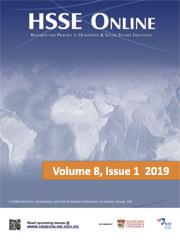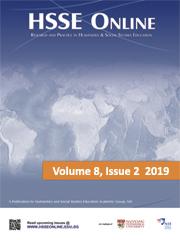HSSE Online EDITORIAL
The second volume of this special issue edition of the HSSE Online continues our conversation on matters related to history education. In this volume, historians, history educators, curriculum specialists, pre-service teachers and experienced practitioners reflect on an integral aspect of history teaching and learning: educational assessment. Bearing in mind recent shifts in syllabus emphases (towards disciplinary history, inquiry-based learning, and an increased focus on formative assessment), our contributors address important implications these developments would have (and have had) on classroom practice and student assessment. While acknowledging the recognizably sturdy emphasis on teaching approaches that prepare students for history exams, the authors believe that this need not be done at the expense of developing proper understandings about history and the past. They argue that a history instruction that provides students with opportunities to work intensively with historical sources, presents them with the means to cultivate historical ways of viewing the past, and is taught in a way that opens up historical knowledge to discussion, debate and conjecture can, in positive ways, affect the growth and quality of adolescents’ historical reasoning, and offer opportunities for formative assessment strategies that are targeted at moving students’ ideas forward.
In his paper, The “Black Rain” – A Re-assessment on the Dropping of “Little Boy” and “Fat Man” on Japan, historian and veteran history educator, Goh Chor Boon, makes a call for teachers and students to think about “assessment” beyond conventional notions of testing for content knowledge and meeting exam requirements, to include wider implications of how historical knowledge is reviewed and re-assessed by historians and historiographers. Understanding history, he argues, requires that students see the significance of events in context, develop insights into the social and moral values that led to events in history, and cultivate sensitivity to the memory of people who lived and suffered in the past. He believes that studying wider historical narratives can help students assess objectively their perceptions and understanding of events that shaped world history.
Leading American history education professor, Keith C. Barton, takes on a key idea raised by the previous author and proposes that history teachers introduce students to the practice of having historical discussions in the classroom as an authentic way to move beyond traditional tests and history essays. In his paper, Assessing Historical Discussion, he presents a cogent, well-thought-out and highly useful elucidation of specific discussion skills and how to teach them, and offers expert guidance on pragmatic assessment procedures and the various ways teachers can assess students’ historical discussion. He cautions, however, that assessing historical discussions is not easy and that any teacher who wants to engage in the process will need to carefully consider the three main tasks described in his paper: identifying which skills to assess, know how to teach them, and know how to manage the task of providing feedback.
The discussion on historical practice and how this is translated in the history classroom continues in Edward Tan Yu Fan’s paper, What Does it Mean to Make Inferences? In putting forward the view that the practice of making historical inferences is a complicated mental process of inductive reasoning, the author raises several problems with how inferences are construed and currently understood in the context of source-based assessment. He offers visual mappings of source-based skills in relation to the inquiry cycle and in the context of real historical writing, and demonstrates how source-based questions that assess the skill of “making inferences” can be improved with better phrasing and precision. He also proposes a way for teachers to rethink the way the levels of response marking scheme (LORMS) are constructed to accurately reward the moves that go towards making proper historical inferences.
Source-based assessment is also a key concern for Ong Rachel Daphne in her paper, Assessment for Learning in History: Maximizing Error Analysis to Bridge Students’ Learning Gaps in Answering Source-based Case Study Questions. Her students’ apparent preoccupation with marks and grades rather than feedback expressly written to improve their learning led her to design a comprehensive error analysis lesson package that was student-centric and focused on tracking each student’s progress and learning gaps in answering Source-Based Case Study (SBCS) questions. Leveraging on Assessment for Learning (AfL) principles, her Error Analysis lesson package (described in detail in her paper) was found to have benefited her students in several ways, such as in enabling them to recognize their own learning gaps, in helping them to write better essays, and in promoting greater opportunities for self-monitoring and self-regulation.
Identifying students’ learning gaps also appears to be the focus of the next two papers, both of which have proposed ways to help teachers identify and extend students’ pre-existing understandings of specific historical concepts. In their paper, Developing Formative Assessment Designs on Evidence for A-Level History, Celine Oon and Bertrand Tan highlight the challenges in conducting formative assessments in history at the A-Levels amidst the prevalent practice of assigning students essay tasks in response to past year examination papers. They recognize the limitations of such tasks in gathering precise information on students’ knowledge of historical concepts and skills, and propose instead two formative assessment designs – MCQs and short answer questions – that can work towards assessing students’ understanding of historical evidence and its role in the construction of historical knowledge. By adapting the Historical Assessments of Thinking (HATs) onto the local context and related assessment constructs, they were able to develop formative assessment tools that can be quickly used to allow teachers to reasonably make accurate inferences about students’ learning gaps.
The next paper by pre-service teachers, Bradley Soh Chun Ying and Sim Guo Chen, looks at the use of Weighted Hinge Questions (WHQs) to Assess Students’ Causal Understanding. In their paper, they highlight the benefits in using weighted multiple-choice hinge questions as formative assessment instruments to promptly identify students’ learning gaps, and offer them the opportunity to receive useful and targeted feedback that can help them build better historical understandings. They offer an in-depth explanation of their weighted multiple-choice hinge questions concept and demonstrate the use of these WHQs across two examples based on a progression model on historical causation developed by British researchers. They argue that when paired with a differentiated instruction approach, students’ WHQ responses can offer a concrete basis for pedagogical adjustment to help students better appreciate the complex and multi-faceted outcomes of each cause and the inter-linkages between the various causes.
The final paper in the line-up takes on a somewhat different approach in discussing the topic. In their paper, Sparking Joy in History Classrooms, Mark Baildon, Chelva Rajah and Suhaimi Afandi offer an initial exposition on a recent educational discourse that focuses on cultivating the “joy of learning” in schools and discusses what this may mean for history teaching and learning. They argue that nurturing a “joy of learning” entails embracing broader purposes of education, while moving away from extrinsic focus such as exam preparation, test results, international comparisons, and other external indicators of educational success. They invite readers to reflect on ways to contribute to joyful experiences in the classroom and suggest a few approaches to spark joy in the history classroom. Apart from fostering joyful relationships, offering variety in learning experiences and giving students autonomy in their learning, they believe that making assessment more meaningful, manageable and purposeful can also lead to positive and joyful experience for students. They conclude that only when history students realize that assessments are necessary for their own learning and development, will they no longer find them daunting.
Suhaimi Afandi
Editor, HSSE Online


